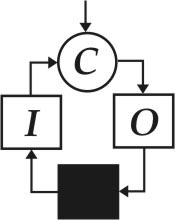|
About PCT and this web site
It isn't what we don't know that gives us trouble, it's what we know that ain't
so.
— Will
Rogers
Living Control Systems Publishing is dedicated to introducing and explaining
Perceptual Control Theory (PCT),
a new conception of how all living things function.
PCT offers answers to questions
such as:
- Do people and animals really respond to stimuli?
- Is 'purpose' a metaphysical concept, or can it actually be defined, observed
and demonstrated with a fully functional physical model?
- Can we ever agree on a definition of behavior, explain how it works and show
what it accomplishes?
- Do we control our actions?
- Just how can a body, a stack of bones stood end-on-end, stand up and walk?
- Why is conflict so pervasive? How does it come about, and what ways are there
to resolve or reduce it?
- How can behavior be organized to satisfy purposes at more than one level at
the same time?
- What about stimulus-response psychology?
- What about cognitive psychology?
- How can people and animals produce consistent results, again and again, in
an unpredictably variable world?
An increasing number of scientists view PCT as a step toward a new understanding
of living systems. The explanations offered by PCT hold up to scrutiny the way
principles in the physical sciences hold up to scrutiny. The books offered at
this site—and equally important, the tutorials and simulations you can run
on your own computer—will help you decide for yourself.
All contemporary flavors of psychology—and there are many—presume
linear causality, from the environment to behavior, as in behaviorism,
or from the brain to behavior, as in cognitive psychologies. The new conception
we call PCT shows clearly that the key quality of life is circular causality,
as in negative feedback control—employed in engineered devices such as the
Segway two-wheeled scooter which stays upright as you ride it, autopilots that
keep airplanes flying smoothly when buffeted by winds, and your home heating system
which keeps the temperature at a desired level.
Perceptual Control Theory lays a foundation
for a psychological science that will be "natural" in the manner of
physics and engineering.
Books on PCT listed on the index page and in our order form are published by
your host, Living Control Systems Publishing, and by other publishers as shown.
The Subject matter section of this website, About
PCT, features a number of statements, tutorials, and simulations to introduce
and demonstrate PCT. I have collected, formatted, and brought up-to-date a number
of explanatory introductions and technical papers right here, as well as many
tutorial and demonstration programs. You can open and print the introductions,
explanations and perspectives using Adobe Acrobat Reader version 5 or later. (There
are well over 300 pages of pdf-files here.) You can download and run the tutorials
and simulations on your own Windows computer.
If you read a book on PCT and skip these tutorials
(which explain how circular causation works in great detail) and simulations (which
show applications of this insight to various behaviors), chances are you will
read it as an interesting story, one more book on psychology, albeit one with
a different perspective and opinion. If you study the book, take time out to run
the tutorials and simulations, and consider the evidence with care, you may realize
that you are joining a revolution, an intellectual upheaval, where non-functioning
metaphors and word pictures are replaced with physically feasible, functional
explanations that provide a new and different perspective on how life works.
Living Control Systems Publishing itself publishes People
as Living Things: The Psychology of Perceptual Control by Philip J. Runkel at this time and just published its prequel, Dialogue Concerning the Two Chief Approaches to a Science of Life. Also available are The
Method of Levels: How to do Psychotherapy
Without Getting in the Way by Timothy A. Carey, Management and Leadership:
Insight for Effective Practice by Dag Forssell, and Casting Nets and Testing Specimens by Philip J. Runkel .
People as Living Things by Philip J. Runkel
introduces PCT and relates it to the full range of human experience, as well as
to the vast literature of contemporary psychologies. Phil's eminently readable
style combined with his extensive knowledge of contemporary psychological literature
sets this work apart as the preeminent review of what the implications of PCT
might be as seen from numerous angles.
Dialogue Concerning the Two Chief Approaches to a Science of Life in book form is
a complete record of the correspondence between Philip J. Runkel and William T.
Powers from its inception in 1985 through 1990. This lucid, focused correspondence
between two eloquent gentlemen is a delight to read and makes for a rather complete
tutorial on PCT. Some written materials that were passed on and discussed in the
course of this correspondence will be included as enclosures.
The Method of Levels: How to do Psychotherapy
Without Getting in the Way is a remarkably effective application of PCT to
problems of chronic psychological distress. Tim Carey's forceful, compelling presentation
makes this volume a superb extension of previously available PCT literature.
Casting Nets and Testing Specimens, first published in 1990, has been revised and updated and is now available in paperback. This work provides a devastating, but, at the same time, diplomatic critique of conventional research methods in psychology, and provides a a better alternative.
Happy reading and studying—and welcome to the PCT revolution!
Dag Forssell
|

